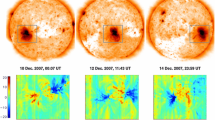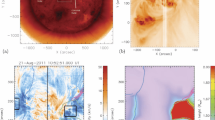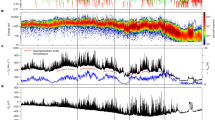Abstract
Recent studies show that active-region (AR) upflowing plasma, observed by the EUV-Imaging Spectrometer (EIS) onboard Hinode, can gain access to open-field lines and be released into the solar wind (SW) via magnetic-interchange reconnection at magnetic null-points in pseudo-streamer configurations. When only one bipolar AR is present on the Sun and is fully covered by the separatrix of a streamer, such as AR 10978 in December 2007, it seems unlikely that the upflowing AR plasma can find its way into the slow SW. However, signatures of plasma with AR composition have been found at 1 AU by Culhane et al. (Solar Phys. 289, 3799, 2014) that apparently originated west of AR 10978. We present a detailed topology analysis of AR 10978 and the surrounding large-scale corona based on a potential-field source-surface (PFSS) model. Our study shows that it is possible for the AR plasma to move around the streamer separatrix and be released into the SW via magnetic reconnection, which occurs in at least two main steps. We analyse data from the Nançay Radioheliograph (NRH) in a search for evidence of the chain of magnetic reconnections that we propose. We find a noise storm above the AR and several varying sources at 150.9 MHz. Their locations suggest that they might be associated with particles accelerated during the first-step reconnection process at a null point well outside of the AR. We find no evidence of the second reconnection step in the radio data, however. Our results demonstrate that even when it appears highly improbable for the AR plasma to reach the SW, indirect channels involving a sequence of reconnections can make it possible.










Similar content being viewed by others
References
Antiochos, S.K., DeVore, C.R., Karpen, J.T., Mikić, Z.: 2007, Astrophys. J. 671, 936. DOI . ADS .
Antiochos, S.K., Mikić, Z., Titov, V.S., Lionello, R., Linker, J.A.: 2011, Astrophys. J. 731, 112. DOI . ADS .
Antiochos, S.K., Linker, J.A., Lionello, R., Mikić, Z., Titov, V., Zurbuchen, T.H.: 2012, Space Sci. Rev. 172, 169. DOI . ADS .
Aulanier, G., DeLuca, E.E., Antiochos, S.K., McMullen, R.A., Golub, L.: 2000, Astrophys. J. 540, 1126. DOI . ADS .
Aulanier, G., Pariat, E., Démoulin, P., Devore, C.R.: 2006, Solar Phys. 238, 347. DOI .
Bagalá, L.G., Mandrini, C.H., Rovira, M.G., Démoulin, P.: 2000, Astron. Astrophys. 363, 779. ADS .
Baker, D., van Driel-Gesztelyi, L., Mandrini, C.H., Démoulin, P., Murray, M.J.: 2009, Astrophys. J. 705, 926. DOI .
Bastian, T.S., Benz, A.O., Gary, D.E.: 1998, Annu. Rev. Astron. Astrophys. 36, 131. DOI . ADS .
Bougeret, J.L.: 1973, Astron. Astrophys. 24, 53. ADS .
Bradshaw, S.J., Aulanier, G., Del Zanna, G.: 2011, Astrophys. J. 743, 66. DOI .
Brooks, D.H., Warren, H.P.: 2011, Astrophys. J. Lett. 727, L13. DOI . ADS .
Brooks, D.H., Warren, H.P.: 2012, In: Bellot Rubio, L., Reale, F., Carlsson, M. (eds.) 4th Hinode Science Meeting: Unsolved Problems and Recent Insights CS-455, Astron. Soc. Pac., San Francisco, 327. ADS .
Bryans, P., Young, P.R., Doschek, G.A.: 2010, Astrophys. J. 715, 1012. DOI .
Craig, I.J.D., Fabling, R.B.: 1996, Astrophys. J. 462, 969. DOI . ADS .
Craig, I.J.D., Fabling, R.B., Heerikhuisen, J., Watson, P.G.: 1999, Astrophys. J. 523, 838. DOI . ADS .
Cranmer, S.R., van Ballegooijen, A.A., Edgar, R.J.: 2007, Astrophys. J., Suppl. Ser. 171, 520. DOI . ADS .
Culhane, J.L., Brooks, D.H., van Driel-Gesztelyi, L., Démoulin, P., Baker, D., DeRosa, M.L., Mandrini, C.H., Zhao, L., Zurbuchen, T.H.: 2014, Solar Phys. 289, 3799. DOI . ADS .
Del Zanna, G., Aulanier, G., Klein, K.-L., Török, T.: 2011, Astron. Astrophys. 526, A137. DOI .
Démoulin, P., Hénoux, J.C., Mandrini, C.H.: 1994, Astron. Astrophys. 285, 1023. ADS .
Démoulin, P., Hénoux, J.C., Priest, E.R., Mandrini, C.H.: 1996, Astron. Astrophys. 308, 643. ADS .
Démoulin, P., Baker, D., Mandrini, C.H., van Driel-Gesztelyi, L.: 2013, Solar Phys. 283, 341. DOI . ADS .
Feldman, U., Widing, K.G.: 2003, Space Sci. Rev. 107, 665. DOI . ADS .
Fisk, L.A.: 2003, J. Geophys. Res. (Space Phys.) 108, 1157. DOI . ADS .
Fisk, L.A., Schwadron, N.A., Zurbuchen, T.H.: 1998, Space Sci. Rev. 86, 51. DOI . ADS .
Fisk, L.A., Zhao, L.: 2009, In: Gopalswamy, N., Webb, D.F. (eds.) Universal Heliophysical Processes, IAU Symposium 257, Cambridge University Press, Cambridge, 109. DOI . ADS .
Foullon, C., Lavraud, B., Luhmann, J.G., Farrugia, C.J., Retinò, A., Simunac, K.D.C., Wardle, N.C., Galvin, A.B., Kucharek, H., Owen, C.J., Popecki, M., Opitz, A., Sauvaud, J.-A.: 2011, Astrophys. J. 737, 16. DOI . ADS .
Gnezdilov, A.A., Fomichev, V.V.: 1987, Pism’a Astron. ž. 13, 704. ADS .
Gopalswamy, N., Mäkelä, P., Akiyama, S., Xie, H., Yashiro, S., Reinard, A.A.: 2013, Solar Phys. 284, 17. DOI . ADS .
Harra, L.K., Sakao, T., Mandrini, C.H., Hara, H., Imada, S., Young, P.R., van Driel-Gesztelyi, L., Baker, D.: 2008, Astrophys. J. Lett. 676, L147. DOI .
Holzer, T.E., Leer, E.: 1980, J. Geophys. Res. 85, 4665. DOI . ADS .
Iwai, K., Miyoshi, Y., Masuda, S., Shimojo, M., Shiota, D., Inoue, S., Tsuchiya, F., Morioka, A., Misawa, H.: 2012, Astrophys. J. 744, 167. DOI . ADS .
Ji, H.S., Song, M.T.: 2001, Astrophys. J. 556, 1017. DOI . ADS .
Kerdraon, A., Delouis, J.-M.: 1997, In: Trottet, G. (ed.) Coronal Physics from Radio and Space Observations, Lecture Notes in Physics 483, Springer, Berlin, 192. DOI . ADS .
Kerdraon, A., Mercier, C.: 1982, In: Benz, A.O., Zlobec, P. (eds.) Solar Radio Storms, CESRA Workshop #4, Int. Rep. Os. Astron. Trieste, Trieste, 27. ADS .
Krucker, S., Benz, A.O., Aschwanden, M.J., Bastian, T.S.: 1995, Solar Phys. 160, 151. DOI . ADS .
Kundu, M.R.: 1965, Solar Radio Astronomy, Interscience, New York. ADS .
Lang, K.R., Trottet, G., Willson, R.F.: 1988, Astron. Astrophys. 199, 325. ADS .
Lau, Y.-T., Finn, J.M.: 1990, Astrophys. J. 350, 672. DOI . ADS .
Le Squeren, A.M.: 1963, Ann. Astrophys. 26, 97. ADS .
Lecacheux, A.: 2000, Geophys. Monogr. Ser. 119, 321. ADS .
Linker, J.A., Lionello, R., Mikić, Z., Titov, V.S., Antiochos, S.K.: 2011, Astrophys. J. 731, 110. DOI . ADS .
Longcope, D.W.: 2005, Living Rev. Solar Phys. 2, 7. DOI . ADS .
Longcope, D.W., Parnell, C.E.: 2009, Solar Phys. 254, 51. DOI . ADS .
Luoni, M.L., Mandrini, C.H., Cristiani, G.D., Démoulin, P.: 2007, Adv. Space Res. 39, 1382. DOI . ADS .
Mandrini, C.H., Demoulin, P., Henoux, J.C., Machado, M.E.: 1991, Astron. Astrophys. 250, 541. ADS .
Mandrini, C.H., Rovira, M.G., Demoulin, P., Henoux, J.C., Machado, M.E., Wilkinson, L.K.: 1993, Astron. Astrophys. 272, 609. ADS .
Mandrini, C.H., Démoulin, P., van Driel-Gesztelyi, L., Schmieder, B., Cauzzi, G., Hofmann, A.: 1996, Solar Phys. 168, 115. DOI . ADS .
Mandrini, C.H., Démoulin, P., Schmieder, B., Deluca, E.E., Pariat, E., Uddin, W.: 2006, Solar Phys. 238, 293. DOI . ADS .
Mandrini, C.H., Schmieder, B., Démoulin, P., Guo, Y., Cristiani, G.D.: 2014, Solar Phys. 289, 2041. DOI . ADS .
Manoharan, P.K., Kundu, M.R.: 2005, Adv. Space Res. 35, 70. DOI . ADS .
Masson, S., Pariat, E., Aulanier, G., Schrijver, C.J.: 2009, Astrophys. J. 700, 559. DOI .
McComas, D.J., Bame, S.J., Barraclough, B.L., Feldman, W.C., Funsten, H.O., Gosling, J.T., Riley, P., Skoug, R., Balogh, A., Forsyth, R., Goldstein, B.E., Neugebauer, M.: 1998, Geophys. Res. Lett. 25, 1. DOI . ADS .
Mercier, C.: 1986a, Ann. Geophys. 4, 469. ADS .
Mercier, C.: 1986b, J. Atmos. Terr. Phys. 48, 605. ADS .
Mercier, C., Genova, F., Aubier, M.G.: 1989, Ann. Geophys. 7, 195. ADS .
Miralles, M.P., Cranmer, S.R., Kohl, J.L.: 2004, Adv. Space Res. 33, 696. DOI . ADS .
Miralles, M.P., Cranmer, S.R., Panasyuk, A.V., Romoli, M., Kohl, J.L.: 2001, Astrophys. J. Lett. 549, L257. DOI . ADS .
Morgan, H., Jeska, L., Leonard, D.: 2013, Astrophys. J., Suppl. Ser. 206, 19. DOI . ADS .
Neugebauer, M., Liewer, P.C., Smith, E.J., Skoug, R.M., Zurbuchen, T.H.: 2002, J. Geophys. Res. (Space Phys.) 107, 1488. DOI . ADS .
Parker, E.N.: 1963, In: Daniel, R.R., Lavakare, P.J., Menon, M.G.K., Naranan, S., Nerurkar, N.W., Yash, Pal, Sreekantan, V.V. (eds.) Inter. Cos. Ray Conf. 1, 175. ADS .
Parnell, C.E., Priest, E.R., Golub, L.: 1994, Solar Phys. 151, 57. DOI . ADS .
Pick, M., Vilmer, N.: 2008, Astron. Astrophys. Rev. 16, 1. DOI . ADS .
Raulin, J.P., Klein, K.-L.: 1994, Astron. Astrophys. 281, 536. ADS .
Reid, H.A.S., Vilmer, N., Aulanier, G., Pariat, E.: 2012, Astron. Astrophys. 547, A52. DOI . ADS .
Sakao, T., Kano, R., Narukage, N., Kotoku, J., Bando, T., DeLuca, E.E., Lundquist, L.L., Tsuneta, S., Harra, L.K., Katsukawa, Y., Kubo, M., Hara, H., Matsuzaki, K., Shimojo, M., Bookbinder, J.A., Golub, L., Korreck, K.E., Su, Y., Shibasaki, K., Shimizu, T., Nakatani, I.: 2007, Science 318, 1585. DOI . ADS .
Savcheva, A.S., van Ballegooijen, A.A., DeLuca, E.E.: 2012, Astrophys. J. 744, 78. DOI . ADS .
Scherrer, P.H., Bogart, R.S., Bush, R.I., Hoeksema, J.T., Kosovichev, A.G., Schou, J., Rosenberg, W., Springer, L., Tarbell, T.D., Title, A., Wolfson, C.J., Zayer, I., MDI Engineering Team: 1995, Solar Phys. 162, 129. DOI .
Schmieder, B., Mandrini, C.H., Démoulin, P., Aulanier, G., Li, H., Berlicki, A.: 2007, Adv. Space Res. 39, 1840. DOI . ADS .
Schrijver, C.J., Title, A.M.: 2002, Solar Phys. 207, 223. DOI . ADS .
Spoelstra, T.A.T., Kelder, H.: 1984, Radio Sci. 19, 779. DOI . ADS .
Stewart, R.T.: 1977, Radiofizika 20, 1338. ADS .
Suzuki, S., Dulk, G.A.: 1985, In: McLean, D.J., Labrum, N.R. (eds.) Bursts of Type III and Type V, Cambridge University Press, Cambridge, 289. ADS .
Sweet, P.A.: 1958, In: Lenhert, B. (ed.) IAU Symp. 6: Electromagnetic Phenomena in Cosmical Physics, Cambridge University Press, Cambridge, 123. ADS .
Titov, V.S., Mikić, Z., Linker, J.A., Lionello, R., Antiochos, S.K.: 2011, Astrophys. J. 731, 111. DOI . ADS .
Tóth, G., van der Holst, B., Huang, Z.: 2011, Astrophys. J. 732, 102. DOI . ADS .
Uchida, Y., McAllister, A., Strong, K.T., Ogawara, Y., Shimizu, T., Matsumoto, R., Hudson, H.S.: 1992, Publ. Astron. Soc. Japan 44, L155. ADS .
van Driel-Gesztelyi, L., Culhane, J.L., Baker, D., Démoulin, P., Mandrini, C.H., DeRosa, M.L., Rouillard, A.P., Opitz, A., Stenborg, G., Vourlidas, A., Brooks, D.H.: 2012, Solar Phys. 281, 237. DOI . ADS .
von Steiger, R., Geiss, J., Gloeckler, G.: 1997, In: Jokipii, J.R., Sonett, C.P., Giampapa, M.S. (eds.) Cosmic Winds and the Heliosphere, The Univ. Arizona Press, Tucson, 581. ADS .
von Steiger, R., Zurbuchen, T.H., Geiss, J., Gloeckler, G., Fisk, L.A., Schwadron, N.A.: 2001, Space Sci. Rev. 97, 123. DOI . ADS .
Wang, Y.-M., Sheeley, N.R. Jr.: 1990, Astrophys. J. 365, 372. DOI . ADS .
Wang, Y.-M., Sheeley, N.R., Socker, D.G., Howard, R.A., Rich, N.B.: 2000, J. Geophys. Res. 105, 25133. DOI . ADS .
Wilmot-Smith, A.L., Hornig, G.: 2011, Astrophys. J. 740, 89. DOI . ADS .
Wyper, P.F., Pontin, D.I.: 2013, Phys. Plasmas 20(3), 032117. DOI . ADS .
Zurbuchen, T.H., von Steiger, R.: 2006, In: Lacoste, H. (ed.) SOHO-17. 10 Years of SOHO and Beyond SP-617, ESA, Noordwijk, 7.1. ADS .
Zurbuchen, T.H., Hefti, S., Fisk, L.A., Gloeckler, G., von Steiger, R.: 1999, Space Sci. Rev. 87, 353. DOI . ADS .
Zurbuchen, T.H., Fisk, L.A., Gloeckler, G., von Steiger, R.: 2002, Geophys. Res. Lett. 29, 1352. DOI . ADS .
Acknowledgements
We thank the anonymous referee, whose comments improved this article. We also thank A. Kerdraon for his help in processing NRH data. CHM and GDC acknowledge financial support from the Argentinean grants PICT 2007-1790 (ANPCyT), UBACyT 20020100100733, and PIP 2009-100766 (CONICET). The research leading to these results has received funding from the European Commission’s Seventh Framework Programme under the grant agreement No. 284461 (eHEROES project). LvDG and DB acknowledge support by STFC Consolidated Grant ST/H00260/1. LvDG’s work was supported by the Hungarian Research grant OTKA K-081421. CHM, AMV, and GDC are members of the Carrera del Investigador Cientí fico (CONICET). FAN is a fellow of CONICET. We thank D.M. Long for the enhanced XRT image and H. Morgan for the XRT processing software.
Author information
Authors and Affiliations
Corresponding author
Rights and permissions
About this article
Cite this article
Mandrini, C.H., Nuevo, F.A., Vásquez, A.M. et al. How Can Active Region Plasma Escape into the Solar Wind from Below a Closed Helmet Streamer?. Sol Phys 289, 4151–4171 (2014). https://doi.org/10.1007/s11207-014-0582-y
Received:
Accepted:
Published:
Issue Date:
DOI: https://doi.org/10.1007/s11207-014-0582-y




